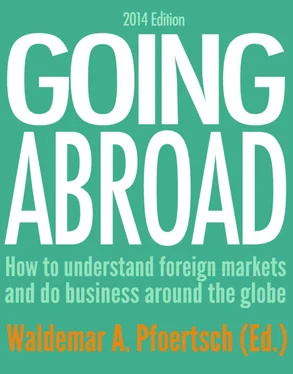It is an unstoppable trend for the development of the world economy. However, for each country, it is also a double-edged sword, both an opportunity and a challenge at the same time. In past years, overseas investments and enterprise mergers and acquisitions, which benefit companies in trading, cash flow, technology transfer or simply cost reduction, have become the important strategies for enterprises’ developments.
“Going abroad” is a trend, a need and a privilege, no matter whether the company is focusing on steady growth or on an ambitious expansion. However ‘going abroad’ is not as simple as stepping out of the house and greeting the neighbors. There is much more to be considered and to prepare before and after the decision is taken.
The book is a treasure book which comprehensively covers every stage and every detail required for going abroad, while it is also a simple handbook, which can be referred to easily once there is a need.
The reader will learn from many examples and descriptions about international business activities. Many companies and places are mentioned. You will even understand why Enzo Ferrari did not sell this company to Ford, and what the intercultural mishaps were when US centric business men wanted to be successful in Europe and vice versa.
In twelve chapters the “how to do business abroad” is described in a very illustrative way. The reader will experience difficult and funny situations and can learn for his own business developments abroad. There are hints and rules to be learned. It is your choice to follow them, but many managers who did are in a much comfortable position today than before.
This book is based on the research of many scholars put together for practical use in the international battleground. It is based on Lennie Copeland’s and Lewis Grigg’s book “Going International”, which was published by Plume Printing in the year 1985 when many US companies were expanding internationally. Now it is the task of many more companies from many more countries, and the practical and theoretical experience of other researchers and practitioners were put together by international business students of Pforzheim University to develop the basis for business around the globe.
Of course not all subjects could be covered, but this overview will lay the ground work for further understanding of doing business abroad.
International Ways of Doing Business
How to understand your own culture and how to behave when dealing with others
Mirja Wagner, Géraldine Quelle, Aline Reichert
AbstractCulture has many meanings. Culture can be a way of life for someone, it can be a person’s background, or it can simply be many different nationalities coming together as one community. For companies on their way to success in international markets, it is important to have a solid understanding of the general rules of a culture in order to become a trusted commercial partner. Managers who wish to be an effective player in the international arena must learn how to behave abroad as well as in the company’s home country. To start off, the reader will be given some explanations on the phenomenon of interactions between people in general and especially on doing business between different cultures.
1 What does culture mean?
1.1 Definition of culture
The word “culture” is a concept, which we deal with unconsciously every single day, and it can be described or interpreted in many different ways. The media is filled with articles and books including the word “culture”, but what does it mean exactly and how can it be defined? The authors Robert Grosse and Duane Kujawa give the following definition in their book “International Business”. “Culture can signify various patterns of behavior, values or beliefs, which are the characteristics of a specific community. A community can be a town, a city, a region, a country or even a company.”
In comparison, Terpstra and David propose this definition: “Culture is a learned, shared, compelling and interrelated set of symbols, whose meaning provides a set of orientations for members of a society. These orientations taken together provide solutions to problems that all societies must solve if they are to remain viable.”
There are several elements that are especially important in order to understand the relationship of cultural matters and global management.
Culture is learned: It is not innate—people are born into cultures and during childhood, adapt and learn the rules and values of their culture. This also means that it is possible to adapt to a new and different culture.
Culture is shared: Members of a particular group share various similarities, which are typical for their culture.
Culture is compelling: The individuals belonging to a certain group are often not aware of their specific behavior resulting from the influence of their culture.
Culture is interrelated: This means that it is important to study a culture as a whole entity. Specific elements should not be isolated, because they have to be understood in the complete context.
Culture provides orientation: A particular group often acts in a similar way to an upcoming problem or situation. Examining a culture can help predict the manner in which group members might react.
1.2 Understanding culture
“The first step to understanding another culture is, understanding your own”. This is a very important statement made by Lennie Copeland and Lewis Griggs in their book “Going International”, which was published by Plume Printing in the year 1985 when many US companies were expanding internationally.
Many aspects, explanations and examples given in this chapter originate from Copeland and Grigg’s publication, but they can also be identified in many other publications. Culture does not only exist in a region or a country, it can also be a significant part of a company. A company can have its own “corporate culture”. Two international corporations, Proctor & Gamble and IBM, are cited by Copeland and Griggs as companies whose cultures are defined by “the American way of doing business”.
If we take the “American way” as an example, we can identify strong and particular attitudes and behaviors that are common at work. Certain things are silently expected, others are declined, forming a special kind of “American glasses” through which the world is viewed, interpreted and evaluated. Copeland and Griggs see a fundamental problem in wearing “cultural glasses”. As travelers and visitors to other nations, people are often not aware of the frame of reference they are carrying along, whether it is American or some other nationality. When confronted by people who eat, dress, communicate and generally act in unfamiliar ways, travelers have difficulties understanding differences and are not aware of influences from their own values and behaviors.
According to Copeland and Griggs, “cultures are not right or wrong, better or worse, just different”. Cultures are shaped by their own logic, which makes it hard for foreigners to understand and make sense of it. Anthropologists explain this phenomenon to have developed from the different climates, terrains or resources that peoples had to adapt to in the past. Just like animals, “mankind evolved diverse solutions to life’s problems”.
1.3 Development of culture
Two important factors that influence the way a culture develops are geography and history. The following examples demonstrate what impact history had on the United States of America and on Germany.
In America, the pioneer spirit permeates its culture. The philosophy of starting out with nothing and then being able to achieve anything in life, if one just works hard enough, is very typically American. Children grow up with a strong sense of pride for their country, being taught that America is a unique and special place, and that they are lucky to be growing up in such a great nation. Up until recently, each school day started out with a recitation of the “pledge of allegiance” and the national anthem is played at the beginning of every sports event. In the attitudes and ways of doing business, Americans are guided by this strong sense of patriotism.
Читать дальше











